Leslie Glass's Blog, page 407
December 29, 2017
Flu outbreak already reported in 36 states, CDC says
As many as 36 states across the U.S. have reported widespread influenza activity already, but epidemiologists say it is too soon to say how bad the flu season will be this year.
The early start of the outbreaks, which usually see a peak in February, is attributed to the low efficacy of the vaccine and possibly the cold temperatures gripping much of the country.
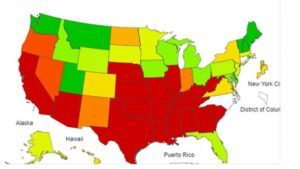

(CDC)
According to the Centers for Disease Control and Prevention (CDC), the strain H3N2 is responsible for the majority of the deadliest cases reported this season.
“It’s just one of those years where the CDC is seeing that this strain of flu is only somewhat covered by the vaccine that was given this year,” said Jennifer Radtke, manager for infection prevention at the University of Tennessee Medical Center in Knoxville, as quoted by USA Today.
“They’re seeing that it’s anywhere from 10 percent to 33 percent effective, so any time there’s a mismatch between the vaccine and the circulating strain of the flu, you’re going to see more cases.”
In the last week of 2017, 21 states experienced high influenza activity and another five qualified in the moderate range.
So far, more than 30 people have been reported dead from the flu this season, USA Today reported. At least 11 people younger than 65 have died in California, while North Carolina has reported 12 deaths and South Carolina seven.
According to CDC data, the flu virus has caused between 9.2 million and 35.6 million illnesses in the U.S. each year since 2010. Those cases resulted in between 140,000 and 710,000 hospitalizations, and between 12,000 and 56,000 deaths each year.
The early start of the outbreaks, which usually see a peak in February, has to do with the low efficacy of the vaccine and possibly the cold temperatures gripping much of the country.
Content sourced from Fox News
The post Flu outbreak already reported in 36 states, CDC says appeared first on Reach Out Recovery.
Addictive substances trick the brain
The brain can experience pleasure from all sorts of things we like to do in life; eat a piece of cake, have a sexual encounter, play a video game. The way the brain signals pleasure is through the release of a neurotransmitter (a chemical messenger) called dopamine into the nucleus accumbens, the brains pleasure center. This is generally a good thing; it ensures that people will seek out things needed for survival. But, drugs of misuse such as nicotine, alcohol, and heroin also cause the release of dopamine in the nucleus accumbens, and in some cases, these drugs cause much more dopamine release than natural, non-drug rewards.
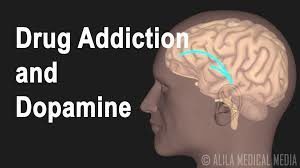
Substances Trick The Brain’s Reward System
Addictive drugs can provide a shortcut to the brains reward system by flooding the nucleus accumbens with dopamine. And, addictive drugs can release two to 10 times the amount of dopamine that natural rewards do, and they do it more quickly and more reliably (helpguide.org).
When Tolerance Develops People Need More
Over time, drugs become less rewarding, and craving for the drug takes over. The brain adapts to the effects of the drug (an effect known as tolerance), and because of these brain adaptations, dopamine has less impact. People who develop an addiction find that the drug no longer gives them as much pleasure as it used to, and that they have to take greater amounts of the drug more frequently to feel high.
Below is a picture (helpguide.org) of the brain and the nucleus accumbens, in addition to some other brain regions that are affected by addition.
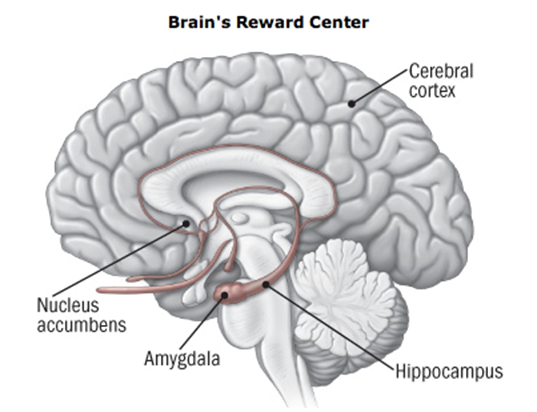
And, here is a picture from Recovery Research Institute’s own research of the brain activated by alcohol (Gilman et al., 2008). The nucleus accumbens is activated.
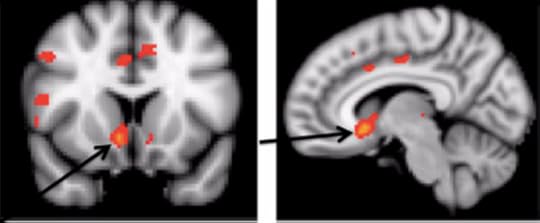
There is a distinction between liking and wanting the drug; as over time, the liking decreases and the wanting increases. Individuals with a substance use disorder continue to seek and use the substance despite the negative consequences and tremendous problems caused for themselves and for their loved ones, because the substance allows them to simply feel normal.
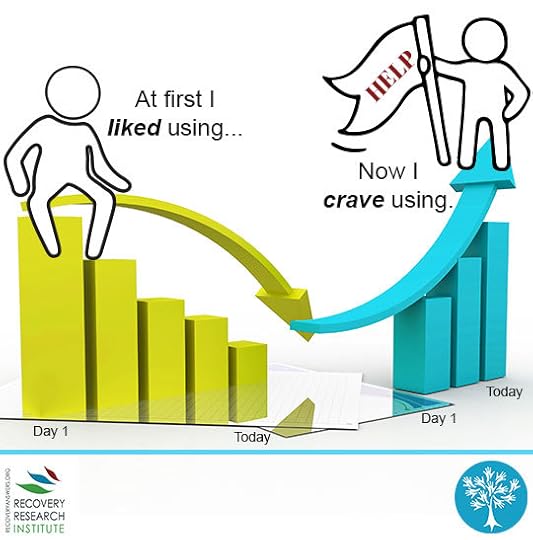
The post Addictive substances trick the brain appeared first on Reach Out Recovery.
Is it time for relationship housecleaning
When overwhelm comes to visit, my tendency is to clean off my plate. I do more than relationship housecleaning. For me cleaning my plate means, everything goes! When I need space, I need space. In the past it has often taken the form of breaking up with whomever I’m dating in the moment. It was easy to let go of relationships which were not a good fit. Time and again, I used overwhelm to test the boundaries. But not this time.
I Found A Balloon
My dad used to say that there are two kinds of people in this world – balloons and rocks. Rocks are the foundation, they are solid, steadfast and strong. Their rough edges can be polished and their tough exteriors can be cracked. People tend to turn to rocks when they are searching for stability and a way to be grounded. Typically, rocks are passive – they let everything wash over them. But in the grip of anger, rocks can deliver a crushing blow.
Balloons, on the other hand, let the wind carry them every which way and in directions they might not have envisioned. Their heads are in the clouds and they are flighty in nature. Balloons crave space, hemming them in creates static. Balloons see life as possibility, albeit many have a string attached.
My dad said I was a balloon. He advised me to find another balloon so that together we could explore and be adventurous, “Tie your strings together and off you go – you’ll end up exactly where you are supposed to be.” Balloons are happiest with other balloons just as rocks are happiest with other rocks. But, when we balloons feel insecure and tossed about by life, our inclination is to slow down. So, we tie ourselves to a rock. Opposites attract and all that.
It works until it doesn’t and when overwhelm rears it’s ugly little head, I’m the first to clip my string and move on. When being tied down suddenly becomes limiting, it becomes scarier than having to rely on my own resiliency. While too much going on at once can be exhilarating, it can also get crowded. And while rocks adapt themselves easily to overwhelm by piling more on, balloons can pop.
So, when the holidays came ‘round this year and my time got crunched with the addition of baking, shopping and parties; I could relax into the space created by being attached to another balloon. After all, he speaks my language.
The post Is it time for relationship housecleaning appeared first on Reach Out Recovery.
December 28, 2017
Kick Start Your New Year – Day 5
It’s not only what you eat that matters, but when you eat. Today’s focus is mindful eating.
Consistent meal timing makes a meal an inevitable occurrence. When a meal occurs, the body is fully satisfied and not looking for something else to eat. It has recognized that what you have just eaten was a meal and it is sated. But there’s more to know.
Don’t Skip Meals
When a meal is skipped or skimped, there is no meal recognition and snacking occurs. When snacking becomes grazing, there are no real meals.
Make The Best Food Choices
Meal planning begins when your hunger level is minimal … say, a 1-2 on a scale of 10. This is ideally when you start looking for something to eat, and when you’ve surrounded yourself with high quality, high energy foods, it’s inevitable that you will eat something that nourishes your body. On day 4, you started paying attention to the chemicals that are in foods, and started choosing foods based on the shortest list of ingredients. Since your pantry is now stocked with foods that are natural and high energy, you’ve made it inevitable that your next meal will be gratifying.
Why Breakfast Matters
“If I wake up ~ I will eat breakfast” is your agreement with your body at the start of each day. Breakfast “breaks the fast” of slumber and serves to energize you for the movement that will follow. Breakfast can look like any number of things … cereal, eggs, a smoothie, pancakes, oatmeal, yogurt, fruit … but it should look like something every day.
Mindful Eating Matters
Sit down and give yourself 20 minutes to enjoy your breakfast, without multitasking through it! No emailing, rifling through mail, budgeting, watching TV, reading or getting anything else ‘done’ during breakfast. No eating in the car either! The mind cannot focus on two things at once; you are either eating breakfast or you are driving. Both cannot take up the same space, one of them must become mindless since the other is mindful.
Did You Know Digestion Is Connected?
The brain sends signals to the gut to initiate digestion; in the case of driving, these signals are halted and then sent to the arms and legs and the parts of the brain dedicated to paying attention. You will not be digesting anything while you are driving because digestion is turned OFF at this time.
The brain recognizes the importance of paying attention while you are driving and the blood is shunted to the extremities to enable survival. Meanwhile, the food you just consumed in the car is sitting in the gut waiting to be digested. In the stomach, the Helicobacter pylori bacteria have been interrupted and the gases which result cause bloating. The food is literally sitting in the stomach waiting for your full attention.
You Eat To Live, So Love To Eat
Remember, you want your body to recognize that you have just eaten a meal … so be mindful while you eat it! Savor the flavors and texture, chew slowly, sip, put your fork down between bites and be present to what you are doing in the moment. Take on mindful eating at each meal.
The post Kick Start Your New Year – Day 5 appeared first on Reach Out Recovery.
Try exercise to improve memory and thinking, new guideline urges
Story Source Mayo Clinic For patients with mild cognitive impairment, don’t be surprised if your health care provider prescribes exercise rather than medication. A new guideline for medical practitioners says they should recommend twice-weekly exercise to people with mild cognitive impairment to improve memory and thinking
The recommendation is part of an updated guideline for mild cognitive impairment published in the Dec. 27 online issue of Neurology, the medical journal of the American Academy of Neurology.
“Regular physical exercise has long been shown to have heart health benefits, and now we can say exercise also may help improve memory for people with mild cognitive impairment,” says Ronald Petersen, M.D., Ph.D., lead author, director of the Alzheimer’s Disease Research Center, Mayo Clinic, and the Mayo Clinic Study of Aging. “What’s good for your heart can be good for your brain.” Dr. Petersen is the Cora Kanow Professor of Alzheimer’s Disease Research.
Mild cognitive impairment is an intermediate stage between the expected cognitive decline of normal aging and the more serious decline of dementia. Symptoms can involve problems with memory, language, thinking and judgment that are greater than normal age-related changes.
Generally, these changes aren’t severe enough to significantly interfere with day-to-day life and usual activities. However, mild cognitive impairment may increase the risk of later progressing to dementia caused by Alzheimer’s disease or other neurological conditions. But some people with mild cognitive impairment never get worse, and a few eventually get better.
The academy’s guideline authors developed the updated recommendations on mild cognitive impairment after reviewing all available studies. Six-month studies showed twice-weekly workouts may help people with mild cognitive impairment as part of an overall approach to managing their symptoms.
Dr. Petersen encourages people to do aerobic exercise: Walk briskly, jog, whatever you like to do, for 150 minutes a week — 30 minutes, five times or 50 minutes, three times. The level of exertion should be enough to work up a bit of a sweat but doesn’t need to be so rigorous that you can’t hold a conversation. “Exercising might slow down the rate at which you would progress from mild cognitive impairment to dementia,” he says.
Another guideline update says clinicians may recommend cognitive training for people with mild cognitive impairment. Cognitive training uses repetitive memory and reasoning exercises that may be computer-assisted or done in person individually or in small groups. There is weak evidence that cognitive training may improve measures of cognitive function, the guideline notes.
The guideline did not recommend dietary changes or medications. There are no drugs for mild cognitive impairment approved by the U.S. Food and Drug Administration.
More than 6 percent of people in their 60s have mild cognitive impairment across the globe, and the condition becomes more common with age, according to the American Academy of Neurology. More than 37 percent of people 85 and older have it.
With such prevalence, finding lifestyle factors that may slow down the rate of cognitive impairment can make a big difference to individuals and society, Dr. Petersen notes.
“We need not look at aging as a passive process; we can do something about the course of our aging,” he says. “So if I’m destined to become cognitively impaired at age 72, I can exercise and push that back to 75 or 78. That’s a big deal.”
The guideline, endorsed by the Alzheimer’s Association, updates a 2001 academy recommendation on mild cognitive impairment. Dr. Petersen was involved in the development of the first clinical trial for mild cognitive impairment and continues as a worldwide leader researching this stage of disease when symptoms possibly could be stopped or reversed.
The post Try exercise to improve memory and thinking, new guideline urges appeared first on Reach Out Recovery.
Kick Start Your New Year – Day 4
How you shop can make a difference in balancing your blood sugar rollercoaster. Let’s consider what you are eating from another perspective, and make a change by mindful shopping. Choose groceries with purpose.
What Is Mindless Shopping?
Mindless grocery shopping… ever done it? You know, when you habitually grab this and that and plunk it into the cart without much of a thought? Perhaps you glance at the nutritional information, but only to count the calories and make a split second decision as to whether or not the food is “good” or “bad” for you.
This is typical of mindlessness. It happens when you operate out of routine because the mind is off and running in fifty different directions. There isn’t any real presence in the moment.
Make a change. Breathe. Slow down. Shop with purpose. Here’s how.
1. Go Mindful Shopping This Week
Set aside 60 minutes to shop at your favorite store. Time yourself on your phone or in some way to make you accountable. Make an agreement with yourself that whatever goes in your cart is composed of ingredients that are natural.
2. Count Chemicals NOT Calories!
The idea is to crowd out foods with a high chemical content in favor of foods that are nutritious and promote high energy. Look at the nutritional information in another way. Focus on the ingredients.
The more nutritious foods have a shorter ingredient list and more energy for you. Likewise, the closer the food is to the farmer, the more energy you will derive from it.
Chemicals are meant to elongate shelf life, not your life!
Food As Nature Intended
In nature, there is a pyramid of energy associated with food. Food chains begin with green plants at the pyramid’s base as they have the highest energy available.
Consumers feeding directly on plants are herbivores (from the Latin “herb” meaning “plant” and “vore” meaning “to eat”) and are found at the next level up. Organisms who feed on herbivores are carnivores (“carn” meaning “flesh”), and are arranged as first-, second- or third-order based on whether they eat another carnivore or an herbivore. Omnivores (“omni” meaning “all”) round out the group; feasting on carnivores, herbivores and plants.
The Best Food For Energy
Organisms in nature choose foods that have the highest level of energy available to them. For this reason, a lion doesn’t hunt a mouse! The lion is innately aware that the amount of energy expended to get the mouse will be in excess of the energy the mouse will actually provide. Lions hunt big game.
3. Hunt For Real Food
We would do well to follow the lead of the lion when planning our meals. Choosing foods that are high energy as opposed to the synthetic foods that spike blood sugar, and counting the chemicals in our choices instead of the calories.
4. Start In The “No Label” Section
Ever notice how there aren’t any labels in the produce aisle? The ingredients in a banana are … well… banana. That’s about as uncomplicated as it gets.
Your mindful shopping starts here. Fill up your cart from this section. Stuck for ideas? Start with what you know, like a basic salad. Then:
Create a new recipe around a fruit or vegetable this week.
Add berries and grapes to salad greens.
Cut up an orange and add the sections along with raspberries.
Pears and blueberries are well mated on a bed of arugula; apples, avocado and cheddar on butter lettuce.
Nuts and seeds like almonds, walnuts, chia, flax and sunflower add crunch and the added benefit of Omega-3 and protein.
Tame the bite of a radish with the sweetness of snow peas and pineapple.
5. Then Look For Other “No Ingredients Listed” Foods
Bump up nutrition with:
Chicken
Fish
Shrimp
Tuna
Other protein sources like beef or pork
Slow down and be mindful of the array of goodies that are available to you. Be curious and notice what foods you are choosing to fuel your body. Your body will thank you.
The post Kick Start Your New Year – Day 4 appeared first on Reach Out Recovery.
December 27, 2017
40% at sports events drink alcohol and it’s a problem
From Science Daily In many western countries, public concern about violence and other problems at sporting events has increased. Alcohol is often involved. Research shows that approximately 40 percent of the spectators drink alcohol while attending U.S. baseball and football games, especially when alcohol is served within the arenas themselves. Alcohol-related problems can be compounded at large sport stadiums that hold tens of thousands of spectators. This study examined occurrences of over-serving at licensed premises both inside and outside the arenas, and allowing entry of obviously intoxicated spectators into the arenas.
To determine the level of over-serving and inappropriate entry, trained professional actors portraying individuals who were “obviously” intoxicated visited licensed premises inside and outside sporting arenas, and attempted to gain entrance to the arenas. The settings were three arenas hosting matches in the Swedish Premier Football League that were held in the largest and second-largest cities in Sweden. The scenarios were developed by an expert panel, and each attempt was monitored by observers who assessed the rate of denied alcohol service and denied entry to the arenas.
Over-serving and allowing entry of “obviously” intoxicated spectators were frequent at these sporting events. The rates of denied alcohol service were only 66.9 percent at licensed premises outside the arenas (101 of 151 attempts), and 24.9 percent at premises inside the arenas (59 of 237 attempts). The rate of denied entry to the arenas was only 10.8 percent (11 of 102 attempts). The authors noted that the variation in server-intervention rates could reflect a lack of training in responsible beverage service among serving staff at licensed premises inside the arenas as well as entrance staff. This lack of training could contribute to unacceptably high intoxication levels among spectators and contribute to increased alcohol-involved problems within the arenas in Sweden. These findings have implications for alcohol consumption at sporting events in other countries as well, including the United States.
The post 40% at sports events drink alcohol and it’s a problem appeared first on Reach Out Recovery.
3 Day Detox During the Holidays
3 Day Detox
3 Day Detox. What is it and why now? Why indeed. This is the highest calorie consumption time of the year. It doesn’t just start with Thanksgiving. It starts with Halloween and everything falls apart after that. Pre Christmas parties, during Christmas parties, reunions, office parties. There’s absolutely no way to avoid consuming too many carbs and sugar, sugar, sugar, sugar. Kudos to you if you don’t feel you’ve overdone it. For the rest of us, there’s a feeling of discomfort and exhaustion. With the 3 day detox, which is a manageable way to control your weight, you can achieve renewal by the first of the year. The detox is also a good way to curb your sugar intake.
Don’t wait for the New Year. Leap into the New Year’s resolutions now and give it a boost. Try it! Turn a new leaf and jump into the green smoothie detox for the next 3 days. Find 3 days on your calendar where you have a break from parties and dinners for the 3 Day Detox. This is the best time to do it.
Benefits:
Increases your vitamins, minerals and antioxidants intake
Delicious smoothie which satisfies hunger
Keeps you hydrated
Get your skin glowing
Veggies and fruits are full of fiber
3 Day Detox Smoothie:
2 servings
2-3 leaves of kale
1 cup baby spinach
1 apple (red is sweeter than green. It is your choice)
1 small cucumber or half big cucumber
1 bunch or 1 cup broccoli
3-4 stems of cilantro
½ clove of garlic
1 nail size fresh ginger
1 nail size fresh turmeric
¼ lemon (with the peel)
1 tsp apple cider vinegar
¼ tsp cinnamon
2 cups water
1 cup ice (optional)
Instructions:
Wash all the ingredients. Cut the veggies and the fruits. Blend all together. Add more water as needed. You may want to prepare ahead the washed ingredients in a zip lock for the next 3 days. It would be easier just to pick up the bag and throw the content into the blender for each meal. Prepare the smoothies the night before and you will have them ready for you in the morning.
To your health!
The post 3 Day Detox During the Holidays appeared first on Reach Out Recovery.
What you should know about date rape drugs
From Medical News Today By Zawn Villines Any drug that alters a person’s consciousness in a way that makes self-defense or sound decision-making difficult can be a date rape drug.
Most estimates suggest that at least 25 percent or 1 in 4 of American women have been sexually assaulted or raped. Someone the victim knows, sometimes with the assistance of a date rape drug, commits most rapes.
Knowing the most common date rape drugs, their side effects, and the signs of a perpetrator planning to use one can prevent victimization.
Fast facts on date rape drugs:
Many people worry about a perpetrator adding a date rape drug to an alcoholic drink.
The primary sign of being drugged is a sudden, unexplained change in consciousness.
A person who thinks they may have been drugged should seek safety first and foremost.
Types and their side effects

Alcohol and benzodiazepines are commonly used date rape drugs, as they may cause physical weakness and loss of consciousness.
Date rape drugs make a sexual assault, including rape easier in one or more ways, such as:
making a victim more compliant and less able to say no
weakening a victim so they are unable to resist or fight back
making a victim fully or partially unconscious
weakening a victim’s inhibitions, so they consent to sexual activity they may otherwise decline
Any drug that changes a potential victim’s state of mind, including some prescription drugs, street drugs such as heroin, and popular drugs such as marijuana, can be a date rape drug.
The most common date rape drugs are:
Alcohol
Alcohol is the most popular and most readily available date rape drug. About half of acquaintance rapes involve alcohol consumption by the perpetrator, victim, or both. On college campuses, which are a common setting for rape, alcohol-related rape is especially common.
Alcohol lowers a person’s inhibitions, makes victims less aware of their surroundings and is often readily consumed by victims. It can also spur aggressive behavior by rapists and increase their willingness to harm others.
Benzodiazepines
Benzodiazepines are a class of anti-anxiety drugs that can also cause people to feel sleepy. A number of these drugs, including Xanax (alprazolam) and Klonopin (clonazepam), can be used as date rape drugs.
The most popular benzodiazepine date rape drug is Rohypnol (flunitrazepam). Rohypnol causes a victim to feel very relaxed, weakens their muscles, and may cause loss of muscle control. Some victims lose consciousness or feel dizzy and confused.
After Rohypnol wears off, some victims do not remember what happened. Rohypnol comes in pill form but can be dissolved in liquid, such as an alcoholic drink.
Ketamine
Ketamine is an anesthetic that acts quickly to cause feelings of relaxation. Victims may lose consciousness or be confused and compliant. They might not remember what happened while under the influence of the drug.
Unlike most other date rape drugs, ketamine acts almost immediately. A victim may not have time to realize they have been drugged.
At high doses, ketamine can cause breathing problems that may be fatal.
Ketamine comes as a white powder that may change the taste of someone’s drink. Consequently, perpetrators sometimes use it in strong-tasting alcoholic beverages that may disguise the drug’s presence.

What are the uses of ketamine?
One of the date rape drugs to be aware of is ketamine, which is also used as a recreational drug. Learn more about it here.
READ NOW
GHB
Gamma-hydroxybutyric acid (GHB) is a drug form of a neurotransmitter that naturally occurs in the body. Neurotransmitters are chemicals that help nerves send and receive signals.
GHB slows activity in the central nervous system, making users feel groggy, sleepy, and potentially confused.
At low doses, GHB can cause nausea and vomiting. At higher doses, it can cause loss of consciousness, seizures, difficulty seeing, and the inability to recall what happened when drugged.
GHB is easy to overdose on and is often manufactured in home “labs.” Consequently, victims may become extremely sick after being drugged with GHB and it can be fatal.
GHB is a colorless, odorless liquid so a victim may have no idea they have been drugged.
Other date rape drugs
Any drug that changes a victim’s consciousness can be used to facilitate date rape.
In some cases, the victim might even ingest the drug willingly. A person who uses heroin, for example, may be so intoxicated that they do not realize a perpetrator is attempting to rape them.
People who use drugs should, therefore, avoid taking them around certain acquaintances or in settings that might facilitate date rape.

Recognizing the signs of a date rape drug

Feeling confused, losing consciousness, or not remembering recent occurances, are all potential signs of having been drugged.
A person who has recently accepted a drink from another person, even a friend, or who has left their drink unattended should be cautious.
Some signs to watch for include:
feeling drunk despite not having drunk any alcohol
feeling confused or disoriented
losing consciousness
not remembering how you got somewhere
being unable to remember anything after drinking
waking up feeling confused, hungover, or unable to recall the night before
genital or urinary pain and difficulty remembering what happened
torn clothes
Date rape drug or severe intoxication?
It can be hard to distinguish the effects of a date rape drug from those of alcohol, particularly after consuming large quantities of liquor.
People who are accustomed to the effects of alcohol should consider how they normally feel after drinking or when intoxicated. An unexplained change in a person’s reactions to alcohol could mean a date rape drug is involved.
A person who feels significantly drunker than usual should consider the possibility that they have been drugged. The only way to know for sure is to seek medical testing.
What to do if you think you’ve been drugged

If a person suspects they have been drugged, they or a friend should call 911 and ensure they are in a safe location.
It is possible to lose consciousness quickly, so a person should not waste time trying to find the perpetrator or researching whether their symptoms match those of a date rape drug.
Instead, they should immediately tell a trusted friend that they suspect they may have been drugged. They or a friend should call for emergency help by dialing 911 then get themselves to a safe place.
They may want to ask a friend for a ride home or go to a public location and tell someone about the drugging.
Next, they should seek emergency medical care. Date rape drugs leave the body within a few hours, leaving no trace. After going to the emergency room or calling 911, a person should tell the doctor, nurse, or dispatcher that they may have been drugged and request immediate testing.
A person who wakes up to signs they may have been drugged must also seek emergency medical care. A hospital can use a rape kit to test for signs of sexual assault. If the police catch a perpetrator, this kit can be used to prove their guilt.
To preserve evidence, a potential victim should avoid showering or bathing until after the exam is complete.
A person who thinks they may have been a victim of a sexual assault may want to consider contacting their local rape crisis center. The center may be able to send a victim advocate to the hospital or offer phone counseling. To find a rape crisis center, click here
Protecting yourself
Some simple strategies can protect against date rape drugs:
Avoid drinking large quantities of alcohol around strangers.
Adopt the buddy system, always go out with a friend and look out for one another.
Never leave a drink unattended.
Never accept a drink from a stranger.
Never leave somewhere with a stranger, particularly after drinking.
Takeaway
Date rape is never the victim’s fault, yet many victims feel guilty or ashamed. That guilt can prevent them from seeking medical care or reaching out for support to help them recover.
Rapists are the only people responsible for rape.
By acting quickly when a person thinks they might have been drugged or raped, they can protect themselves, help to catch the perpetrator, and potentially mitigate the dangerous effects of date rape drugs.
The post What you should know about date rape drugs appeared first on Reach Out Recovery.
Video game addiction designated mental health disorder by WHO
The gaming disorder is included in a section on “disorders due to addictive behaviors.” To warrant a diagnosis of the new disorder, excessive behavior should be evident for a period of at least a year. But playing lots of video games doesn’t necessarily mean a person has the disorder—the behavior has to significantly impair personal, family, social, educational, occupational or other aspects of your life.
Children’s learning, health and social skills could be positively impacted by playing video games, according to a review of research published by the American Psychological Association. Even video games that have violence may have some benefits. People who play “action” video games, many of which are deemed violent, could improve cognitive skills such as spatial navigation, reasoning, memory and perception. One study found that “shooter” video games improved spatial skills just as well as academic courses specifically designed to enhance those same skills.
Those findings should not replace other studies delivering a more wary message about video games. “Important research has already been conducted for decades on the negative effects of gaming, including addiction, depression and aggression, and we are certainly not suggesting that this should be ignored,” said lead author Isabela Granic, developmental psychopathology professor at the Radboud University Nijmegen in the Netherlands, in a 2013 statement when the review was released. “However, to understand the impact of video games on children’s and adolescents’ development, a more balanced perspective is needed.”
Another study published in 2013 in the Journal of Adolescent Research found that playing video games can enhance motivation, cognitive effort, and increased efforts over long periods of time, as many games require players to reach multiple levels for an ultimate long-term goal. These benefits are similar to what children gain from sports, arts, clubs and hobbies, reported Forbes. University of California, Irvine, researchers found in 2015 that playing 3-D video games can boost memory formation—adding to the literature that shows those types of games can improve hand-eye coordination and reaction time.
The post Video game addiction designated mental health disorder by WHO appeared first on Reach Out Recovery.



